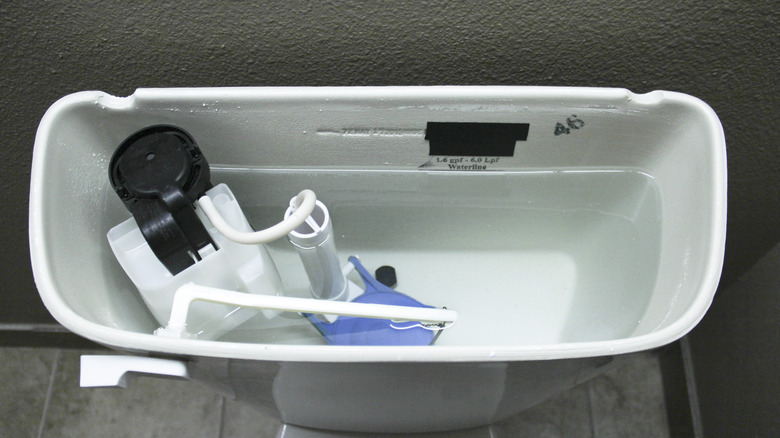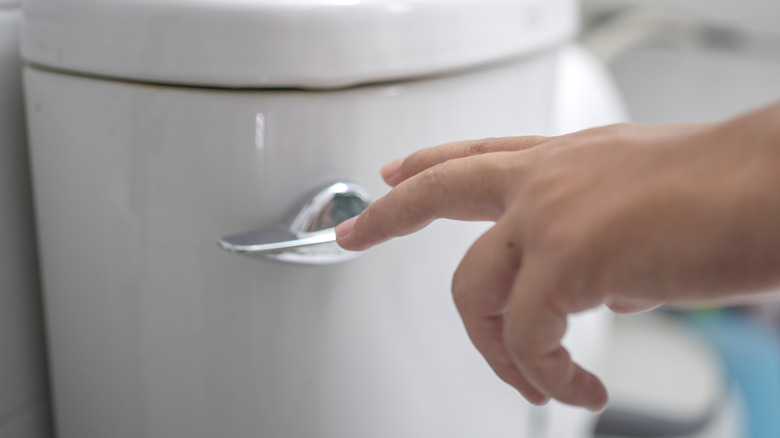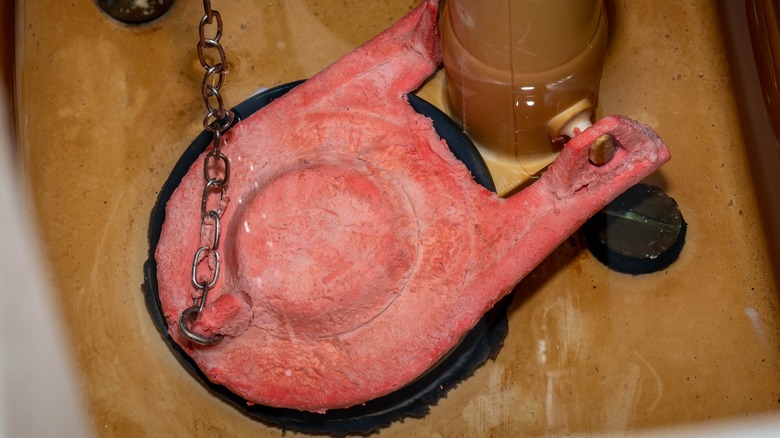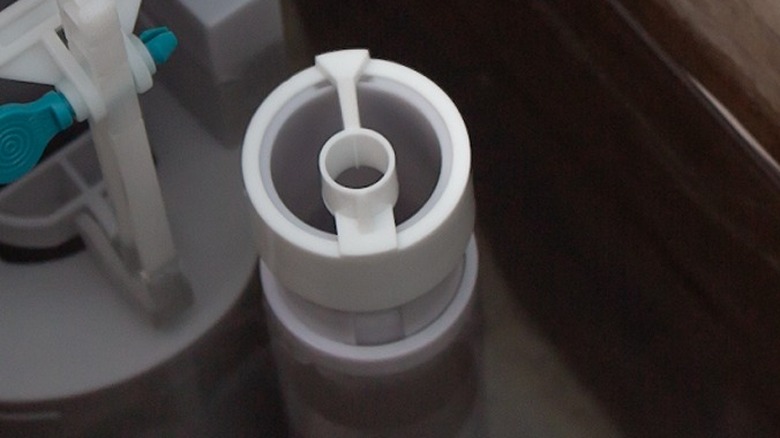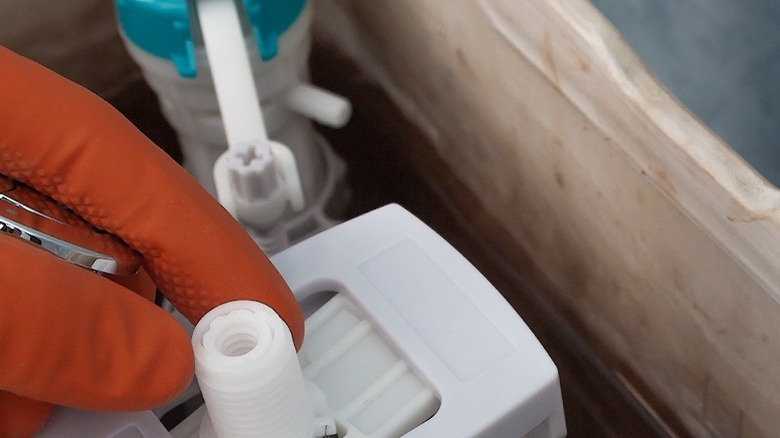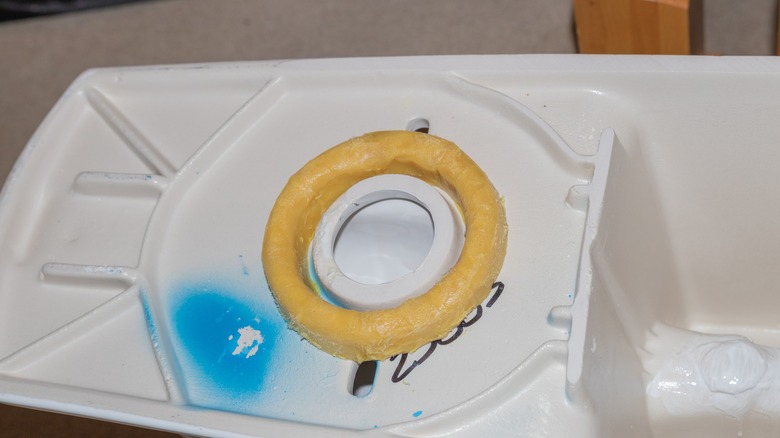A Simple Guide To Understanding How Your Toilet Parts Work
Toilets are seemingly uncomplicated devices whose simplicity is eclipsed by the importance of their function. Arguably, these devices are the most important in a modern home. Just think about it. You can light candles when the lights are out, you can eat dry goods when the stove or fridge breaks down, and you can sanitize your hands if the faucets stop working. But what do you do when your toilet doesn't flush? Just like that, you're in the Dark Ages. And unless you're content to make do with a bucket, there's no alternative to rolling up your sleeves and getting your bathroom companion back to good working order. But to repair a broken toilet, you need to understand how it works — and its workings are more complicated than what meets the eye.
Toilets have no electrical components, no CPUs, and no circuit boards. They do their magic armed with nothing more than water, suction, and gravity. When you push the flush handle, the water leaves the tank and washes the waste in the toilet bowl down the drain. For this outwardly straightforward process to occur without issues like sewage spills, the main parts of the toilet — including the fill and flush valves, overflow pipe, and gaskets — need to work perfectly in concert. Below, we'll explain how each essential toilet component functions and list potential issues that may need fixing on your part.
The flush handle lets the user operate the flush valve
The flush handle is a lever you push to release water from the tank into the toilet bowl. This mechanism comes in several different configurations. Commonly, it will look like a small lever mounted to the front or one of the sides of the toilet. These handles are usually made of metal or plastic; the plastic versions are generally lower quality than metal and wear out faster.
In a typical setup, these handles are connected to a brass arm inside the tank, which, in turn, is fastened to a chain. The second end of the chain connects to the toilet's flush valve. When you push the handle down, the pivoting motion lifts the brass arm inside the toilet and pulls on the chain. The chain's upward motion lifts the flapper, and water that's stored in the tank comes plunging down into the bowl. When you let go of the handle, the flapper reseals the opening at the bottom of the tank, and the water ceases its flow into the bowl.
Not all toilets have lever-operated flushing mechanisms. For example, dual-flush toilets usually come with two flush buttons at the top of the tank. One button activates the half-float to release a small amount of water when flushing liquid waste, and the other triggers the full float to drain the entire tank when there's solid waste. Some single-flush toilets come with pull knobs, which work much like levers and let you lift the flapper in the tank.
The flush valve controls water flow from the tank to the bowl
The toilet's flush valve (also known as the "flapper valve" or simply the "flapper") seals the opening between the toilet tank and the bowl beneath it, and lets the water flow down when you flush. In many standard toilets, this valve consists of a flapper — a rubber or soft plastic plug located at the very bottom of the toilet tank. This flapper connects to the flush handle arm via a chain. In its resting position, the flapper acts as a seal, so the water inside the tank doesn't leak to the bowl. When you need to empty waste from the bowl, you activate the flush valve by pressing the handle or button, or pulling on the knob. This action lifts the flapper from the opening, and the water rushes down to the bowl. Toilets with dual-flush mechanisms usually have seals that are attached to a piston that moves up and down.
Constant exposure to water, pressure, and the stress of being pulled away from the opening it seals all wear the flapper out over time. When this happens, the flapper can no longer keep the tank water from leaking down into the bowl — a common problem you shouldn't turn a blind eye to, unless you don't mind the water waste. This issue may manifest in water constantly trickling in the bowl, or in phantom flushes. For this reason, flapper valves generally need replacement more frequently than other toilet parts.
The overflow tube prevents excess water from flowing out of the tank
The overflow tube is actually a part of the flush valve, and is attached to the flapper. The top of the pipe is open and sits just above the maximum water level, while its bottom connects to the toilet bowl. The overflow tube serves two purposes. Firstly, it prevents the toilet tank from overflowing if any part of the filling mechanism somehow malfunctions. For example, if the float somehow breaks and lets water into its cavity, it will no longer float and won't rise with the water level as it should. With no fail-safes in place, the water would continue filling the tank unchecked and eventually spill over the edge of the tank. A similar situation could unfold if the fill valve itself is worn out and doesn't close properly, letting a constant trickle of water into the tank. Thanks to the overflow pipe, though, if the water level passes its maximum limit, it will flow over the edge of the overflow pipe and make its way down to the toilet bowl.
The second function of this pipe is to refill the toilet bowl after every flush. The fill valve connects to the overflow tube with a small rubber hose known as the "refill tube." Whenever the fill valve gets activated after a flush, this refill tube channels some water down the overflow pipe and into the toilet bowl.
The fill valve refills the tank after flushing
The fill valve activates automatically after each flush and replenishes the toilet tank with water. Fill valves come in two different designs — ball-and-arm (also known as "ballcock valve") and fill valve with a cylinder float. The concept behind a fill valve's operation is similar regardless of the float type. The float is an air-filled vessel that floats on the surface of the water and is attached to the valve. As you flush the toilet, the water level falls and the float drops with it. This downward motion opens the fill valve, and water comes rushing into the toilet tank. As the tank fills up, the rising water level carries the float up, and this upward motion eventually closes the valve and stops the flow of water from the supply line. Tweaking the fill valve is often an easy answer for raising your toilet's water level.
The key difference between the older-style ball-and-arm floats and the more modern cylindrical floats is their appearance and mode of connection to the fill valve. Ball-and-arm floats comprise a spherical float that's connected to the valve near the top of the tank via a metallic arm. This arm pivots as the float rises and falls with the water. On the other hand, cylindrical floats are mounted around a shaft, on which they slide up and down along with the movement of water. With cylindrical floats, the water enters the tank from the bottom of the cylinder, making the refilling process quiet.
Tank O-ring and wax ring prevent leaks
A toilet has two important gaskets that keep water from leaking onto the floor. The first is the O-ring that seals the opening between the toilet tank and toilet bowl. This toilet seal has a circular shape and a beveled edge, which fits perfectly against the hole in the base of the toilet. At its top, it makes a seal against the bottom of the flush valve. This way, the interface between the tank and the bowl is firmly sealed, and tank water can't drip out. Over time, this gasket may wear out. If you notice that water is trickling out from underneath the tank, it's likely time to replace the toilet O-ring. This procedure requires draining the toilet and removing the toilet tank to access the ring.
The other vital gasket — known as a "wax ring" or a "wax seal" — is located underneath the toilet seat, and seals the interface between the base and the toilet flange. The flange facilitates the connection between the toilet and the home's sewer drain system, and fastens the toilet to the floor. Without the wax seal acting as a gasket, sewage would leak from under the bowl and onto your bathroom floor any time you flush. Although O-rings are designed to last as long as the toilet itself (up to 30 years), they can succumb to wear sooner. If you feel that the toilet base is no longer stable, or the toilet bowl isn't holding water, it's probably time to replace the wax ring.
